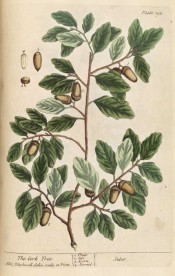Quercus suber L.
Frost-hardy, rounded evergreen tree with thick, corky bark, oblong, toothed leaves, to 7cm long, and ovoid acorns. To 20m. [RHSE, Hortus Hilliers’]. The bark is the source of cork.
Horticultural & Botanical History
Introduced to Britain in 1581. [PD]. ‘This is a kind of ever green Oak, its leaves are thicker and much less indented than the common Oak, and the acorns smaller. It grows in Spain and Italy, and the southern parts of France. The bark, of which they make cork, is separated from the tree by making a long incision from the head to the root of the tree, which they take care to do in dry weather; for the young tender bark is liable to be destroyed, and the trees killed by rain. Cork is said to be restringent and good for all kinds of fluxes; some commend the ashes or burnt cork for the same purposes.’ [Blackwell pl.193/1737].
History at Camden Park
Listed in all published catalogues [T.812/1843]. Several mature specimens are located in the Old Orchard, now the property of the Elizabeth Macarthur Agricultural Institute. This tree was probably introduced for utility rather than ornament.
Notes
Published Feb 03, 2010 - 05:21 PM | Last updated Feb 03, 2010 - 05:25 PM
| Family | Fagaceae |
|---|---|
| Category | |
| Region of origin | Western Mediterranean and north Africa |
| Synonyms | |
| Common Name | Cork oak |
| Name in the Camden Park Record |
Quercus suber - Cork tree |
| Confidence level | high |
